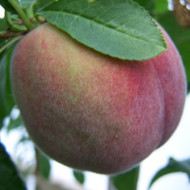As a small child, every Saturday afternoon would entail a visit to my grandmother. A redoubtable woman in every sense, she loved her garden and through spring and summer we would drive out to a nearby garden centre to critically inspect the plants and perhaps stop for an icecream on the way back. Then we’d have a cup of tea in her garden, with slices of lemon drizzle cake. Always lemon drizzle cake.
The pride and joy of her garden was a peach tree, immaculately fan-trained against a small brick outbuilding. I can vividly recall eyeing the swelling fruit, begging to be allowed to pick one, even though they were as small and hard as marbles. Eventually, when the fruit had fully ripened, I would be allowed to harvest a golden amber fruit. With all the formality of a Japanese tea ceremony, a small side plate and a fruit knife would be produced, and the peach cut into 4 pieces to share with my siblings. A home-grown peach, in a small suburban garden on the outskirts of Coventry in the mid 70’s, was a rare treat indeed.
Peach trees have a bad reputation- susceptible to frost damage, plagued by pest and disease, and highly demanding of soil and situation - they are seen as the divas of the fruit world. Whilst there is a little truth in this (I wouldn’t advise trying to grow one in the open at the top of the Cumbrian fells, for example), with a little planning and some basic knowledge, they are a realistic proposition for many gardeners in the U.K..
Peaches, along with nectarines, are members of the Prunus family, more specifically Prunus persica. Originally from China, where they had been cultivated for almost 6000 years and were considered food fit for the Emperor himself, peaches arrived in Rome from Persia through the Silk Route. The Romans spread the cultivation of the peach throughout the Mediterranean, but the unfavourable climate meant that peaches were not grown in the U.K. until much later, when large estates and country houses would have specific greenhouses built to accommodate the fruit. It was considered an expensive luxury, and head gardeners would compete to grow the best fruit for the table. After the Victorian era, increases in the cost of labour and coal meant that many such glasshouses fell into disrepair or were used for other purposes, and peaches seem to have retained this reputation for only being for the aristocrat, and beyond the scope of the normal gardener.
Cultivation.
It probably goes without saying that a peach tree needs the sunniest, most sheltered site in your garden to do well. The trees themselves are very hardy - down to minus 20c - but they flower very early in Spring and the blossom has no frost resistance. Fan-training against a brick wall is ideal, as the bricks absorb heat during the day and release it at night, but even a wooden fence will provide some protection. Training against a wall also makes it easier to drape a length of horticultural fleece over the tree if frost is forecast while in flower.
All varieties are self fertile, so no need to grow a partner tree. The issue is normally that the weather can be cold and grey that early in Spring, so bees may not be flying. Help your tree along by taking a soft haired brush and gently brushing open flowers, which transfers pollen and helps fruit to set.
Peaches like that holy grail of garden soils - well drained, but moisture retentive. As I’ve yet to find a garden where this actually exists, err on the well-drained side if in doubt. Peaches will hate sitting in heavy clay through the winter, so add plenty of organic matter and grit to improve drainage if required.
During the summer months, the fruit can split if the tree gets too dry, so a thick mulch in late Spring when the soil is damp is highly recommended. If necessary, water well once a week during the summer.
Pests and diseases.
Peach leaf curl is THE major problem for peach trees. Fungal spores which arrive on winter rains cause the spring foliage to deform, turning them red and yellow. The leaves are then not able to photosynthesise properly which weakens the tree. Repeated severe attacks can eventually kill the tree. Prevention is better than cure, and the best way is to keep the foliage dry in the winter. Overwinter potted trees indoors if possible - trees grown in poly tunnels and greenhouses are never affected. Old Victorian walled gardens sometimes had intricate glass and wrought iron shelters installed to keep the fan trained trees protected but plastic sheeting works just as well.
Some varieties have a natural level of resistance to leaf curl. ‘Avalon Pride’ was the first, discovered growing wild in woods in Washington State, USA. more varieties have been subsequently bred - look for ‘Red’ in the title, as this normally indicates good resistance. Applying a copper based fungicide in early autumn and again at bud break can help. Otherwise if you do notice foliage puckering, follow my grandmother’s lead and pick off the leaves. You do need to give the tree a good feed with a balanced fertiliser at the same time, to encourage fresh foliage as soon as possible.
Pruning.
As for all stone fruit, only prune in dry weather in spring and summer. Peaches fruit almost exclusively on one year old wood, so prune some of the branches quite hard each year to encourage a fresh flush of new growth. Old trees can easily be rejuvenated by a hard chop back. Fruit thinning is just as important as pruning - remove up to half the fruitlets after fruit set. This allows the remaining fruit to get to full size and ripen properly without weakening the tree.

